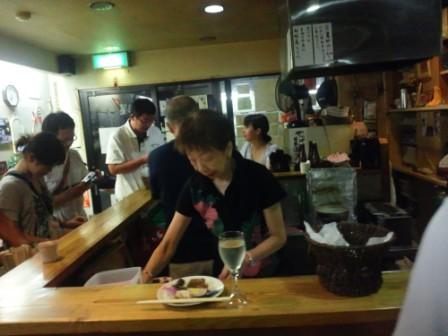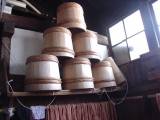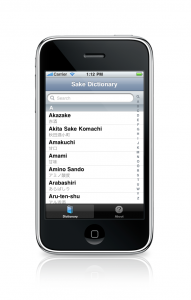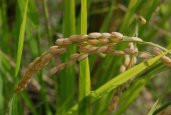|
|
|
Happy New Year to all readers,
First and foremost, I pray for health, happiness, prosperity, and stability for everyone in 2012. Last year, 2011, was a doozy. And it is behind us now. May we all learn from what transpired and move forward with humility and in balance with all that is.
Just last night I came back from a visit to my hometown of Cleveland, Ohio (the home of eternal sports-fan agony), and was moved again at the beauty of this season. The town in which I live, Kamakura, has a long history (like 900 years) and sees hundreds of thousands of visitors in the first few days of the new year. The lantern-lit path that leads to the ancient Shinto shrine Tsurugaoka Hachimangu, frequented by the first shogun, Minamoto no Yoritomo and his descendents, is a thing of eternal beauty. Getting to see that upon my return seemed a fitting start to the new year, for which we all have great expectations.
Like many major Shinto shrines, near the main worship area we can find a veritable wall of sake, filled with (alas, empty) taru (casks) ostensibly provided as offerings. While they serve as little more than advertising in these modern times, the Wall of Sake at this shrine boasts quite an excellent and diverse range of sake.
Should you be feeling especially sake-spontaneous there is one single seat remaining open for the Sake Professional Course in Japan, to be held January 23 to 28, i.e. very soon. Please contact me if interested.
Warm regard, please enjoy the newsletter, and again: all the best in the coming year, 2012, the Year of the Dragon.
John
 
|
Every Year, It's Back to First Grade
As soon as you think you got it, it’ll hose you.
During a recent sake-pub crawl organized by a handful of brewers in
 |
|
Shizuoka Prefecture, my group of ten or so stumbled, er, walked into a small establishment with a U-shaped counter. As the staff prepared the decided-upon nibbles, we found ourselves a (very happy) captive audience to Kazutaka Takashima, owner-inherit and toji-understudy of the kura making Hakuin Masamune. He was chatting on enthusiastically about his on-the-job experiences learning sake brewing from his master brewer.
As we listened, we sipped on his most recent season’s manifestation, a junmai yamahai. It was round, raisin-buttery at first, then dove-tailed by an increasingly prominent acidity. And it was awesome.
“Somehow, it came out alright this year,” he said with typical modesty. “But that don’t mean jack come next season! I’ll be starting from scratch again.”
He described how he was working toward taking the brewing reigns from the aging toji in due time. While long ago this almost never happened, owners taking over as master brewers is increasingly common in the sake world today. It only makes sense, and in today’s economic environment, almost nothing else does.
 |
|
“Like my toji-san says, the moment you think you understand it all, it’ll come back and bite you on the bum!” And he punctuated this statement with one commonly heard in the sake world, “Every year it is back to first grade.”
Indeed, we hear it over and over. The moment you think you understand - or can consistently control - the sake brewing process, it will bite you on the bum. It will go out of its way to do so. It will cross town just to get you.
You get complacent, you are hosed. Any toji (master brewer) will tell you the same thing: Every year, it’s back to first grade.
Why is this? Because of the subtle but cascading effects of each step of the process and the leverage that the details impart. No two years are the same.
The rice is different every year, and it takes brewers the first few batches to figure it out. The weather within which they will ferment and mature will change from year to year. Equipment breaks down or gets old, and gets replaced by units with which the staff have less familiarity. Personnel change, and with it the level of competency for a given process. And brewers take on challenges of new products, new rice types, and new market needs.
During a visit to one kura, the toji told me, “Listen, we don’t really brew this stuff! We just try to maintain a sanitized and otherwise appropriate environment to allow it to brew itself. It has a mind of its own. We can only guide it, and help it to do its own thing.”
Certainly, the same could be said for wine, beer or any other craft product. But add to that a culture of craftsmanship that agonizes over an excruciating attention to detail. When most folks hassle threshold is tripped, they might say, “Do we really need to go that far? It can’t really make a much of a difference!” But that right there is the departure point for true quality in sake brewing.
A ways back I read an article in the Japan Times about how much attention to detail can go into even making a cup of coffee in Japan. The author was told by a master coffee maker that making a cup of coffee using a method known as nel dripping take 30 years to master. The author expressed his sentiments on that by stating that, “In Japan, everything from rolling a rice ball to flushing a loo takes 30 years to master…” By all means, add sake brewing to that list.
While I am admittedly off on a tangent, this can also be seen in hte world of
itamae, journeymen that prepare traditional Japanese food from behind a counter. One can stand next to a sashimi-cutting master, use the same knife, apply it to the same fish, and mimic that master motion for motion. But simply from the invisible differences the master imparts from decades of experience will actually make his cut taste better. Preposterous? On the surface, perhaps. True? Absolutely.
And again, the same concept will apply to every single step of sake brewing. Add to that the fact that rice, weather, equipment, personnel and more are changing constantly, it’s no wonder that every year it’s back to first grade.
While this is cool, and romantic, it could also be a governor on the
 |
|
engine of sake’s growth around the world. Why? Because compared to other premium sipping beverages, it is not as easy to replicate super premium product, nor is it at all easy to ramp up production to the level where economies of scale kick in and still keep consistency and quality. And therefore, it is not as easy to justify huge marketing money outlays.
Still, sake continues its growth overseas, and will continue to gather followers, fans and aficionados, step by step. But just how do we go about helping that? Well, in this changing world, every year, it’s back to first grade.
|
|
The State of the Sake Industry
January, 2012
We all know well what the sake industry has gone through this past year.
 |
|
The effects of the triple tragedies of March 11 were huge to say the least, and things have been compounded by other external factors as well.
In truth, both the present and the future are a bit hard to see with any clarity. We are moving forward as if leaping across stepping stones in dense fog over a fast-flowing river: one can hardly see even the in which direction the next leap of faith will be.
But how is this resilient industry doing right now? Well, not too bad… or so it seems. Statistics can be very deceiving. There are oodles of them: up five percent this month, down three percent the next, up seven the next month but down half a percent year-to-date. Huh?
It is all quite hard to nail down. However, there are three trends I see that are reassuring. One, sake is doing better than other alcoholic beverages. In fact, for this year, sake may be the only one holdings its own. People have been drinking less this year, but choosing sake a bit more often. Two, sake consumption has dropped every single year save one since 1974, and so again at least by comparison, even a little upward blip is good news. And third, even in this past year, exports rose a healthy dollop, to the tune of 24 percent! All countries that ceased importing over various concerns have resumed, save for Russia and Brazil.
But here is a reality check: Yes sake is growing overseas, but hey, a 24 percent increase on 1.7 percent of total sake produced is really just a 0.41percent increase overall. That’s zero-point-four-one percent.
There have been a handful of well-publicized Tohoku-region success
 |
|
stories. Suisen right in the Rikuzen Takada, hardest hit by the tsunami, as well as Senryo Otokoyama in Miyako and Hakurakusei further inland, which were both very heavily damaged in the shaking. All three have recovered and are brewing this year. There are many other comeback stories that have not been told.
But this year will be the next test. The current brewing season, now about one-third through, seems to be going well and last season’s rice is cooperating. But will it sell? Will consumers in Japan, who represent 98% of the market, continue their reticent embrace of the national beverage? Only time will tell.
The plethora of problems are not just related to the triple tragedies. Japan’s lackadaisical economy is not helping, and it could still get double-whammied by suffering economies elsewhere and the worst exchange rate
ever. If breweries make zero money exporting, it does not matter how much those markets grow!
Statistics and reports will begin to trickle out as this season’s sake starts
 |
|
to ship. Next month, we will look at reports on those numbers, as well as issues including problems such as price wars, sake tax breaks for small producers, and rice prices and supplies. Hopefully things will begin to come a bit clearer. If not, at least we can begin to see that next stepping stone, through the mist.
More information will be posted on my blog, as it becomes available, at
http://sake-world.com/wordpress/
Would you like to know when new stories are posted? Please follow me on Twitter.
|
Sake Basic / Did you know?
"Horoyoi"
Let’s face it: this newsletter is about alcohol. Sure, it is more overtly about craftsmanship, heritage, history, culture, and wonderful flavors and aromas. It is about pride and preserving something valuable, something that is the livelihood of thousands and thousands of families. But the substance that is the manifestation of all of this is, in the end, an alcoholic beverage.
 |
|
I tend to focus on the technical, cultural, and historical aspects of sake in this newsletter. I try to cover topics that help people understand and enjoy sake and all that suffuses it. But all too often I steer clear of the idea that, hey, drinking this stuff will actually get you buzzed or, heaven forbid, drunk (perish the thought!), and that it must be enjoyed in moderation.
Not this month. This month I want to introduce the concept of horo-yoi, a beautiful Japanese word if there ever was one.
Horo-yoi is nothing difficult: It simply refers to a little buzz, with the emphasis on little. My own interpretation would be the buzz we feel when we drink just enough to start feeling it, or perhaps just a smidgeon more after that. The glow we feel from just a very little bit of sake.
Why am I detailing Japanese buzz words? Because it is such a reasonable, common-sense,
appropriate concept. Not that everyone in Japan embraces it – heck no! Not that I do very often either. But these facts do not detract from the balanced and good concept that horo-yoi is.
I have often read in various sake-related literature that just the right amount of sake to drink is “ni-go-han,” or two and a half glasses, as that leads to a horo-yoi, and no more trouble after that. Obviously this will vary wildly from person to person and time to time. But the concept is solid: hold back a little bit from what you might tend to do naturally and enjoy the very light buzz that horo-yoi expresses.
You know it when you feel it. Stopping when you have it, and either letting it go gracefully or maintaining it just a little bit longer is what the spirit of horo-yoi is all about. And sake as well.
|
 Announcements and Events Announcements and Events
Sake Professional Course in Japan
January 23 ~ 28, 2012
Due to a last-minute cancellation, one last seat remains. If you have the motivation and interest, not to mention the requisite spontaneity to your nature, please contact me by email.
From January 23 to 28, 2012, I will hold the 9th annual Sake Professional Course in Japan. This is it, folks, the most intensive, immersing, comprehensive sake educational prog ram in existence. Three days of classroom lectures and tastings (capped off each night with a scrumptious sake dinner at one of Tokyo's best sake pubs) are followed by two days of brewery visits to lock it all in. It will conclude with certification testing for the Certified Sake Specialist, recognized by the Sake Education Council. ram in existence. Three days of classroom lectures and tastings (capped off each night with a scrumptious sake dinner at one of Tokyo's best sake pubs) are followed by two days of brewery visits to lock it all in. It will conclude with certification testing for the Certified Sake Specialist, recognized by the Sake Education Council.
The cost for the course, including all five days and evening meals as well, is 180,000 yen. For more information about the daily schedule and to read a handful of testimonials, click here . Feel free to contact me directly at sakeguy@gol.com with any questions about the course, or to make a reservation.
Sake Tours, 2012 ~ Akita and San-in
Sake Tourism is alive and well! Check out this year's Sake Tours
for sake-heavy tourism of Japan. Not nearly as intense as the Sake Professional Courses, and sake is not the only thing you will experience on these special tours! But certainly, they are "sake heavy."
From the website:
Please join us for a very special journey through the regional brewing and culinary traditions of Japan. Tour destinations are filled with moments you cannot experience otherwise. In 2012, we will return to San-in, the land of myth, and to the snow country of Akita for special breweries and onsen.
Meet and speak directly with artisans to appreciate their history, philosophy, and the art of brewing. Learn from the world's best sake educator, John Gauntner, and share the passion of brewers for their craft. Then, wind down at onsen to relax, and simply have fun!
Learn more and register now at the Sake Tours Website.
Sake Education Council Website
Please take a moment to check out the website for the Sake Education Council, the organization behind the Certified Sake Professional and Advanced Sake Professional certifications. We plan to grow steadily, strongly and continually, and we will need the support of all those that love sake to do so. Follow us through the "usual suspects" of social media.
Sake Homebrewer's Online Store
Please be sure to check out Homebrewsake.com for supplies, information and a forum, including lots of supporting information on everything from recipes to history. I have been meaning to mention this site and the gentleman behind it, Will Auld, but have repeatedly forgotten in past newsletters. The site is replete with instruction, augmented with videos, schedules, and more. If you are even remotely interested check this site out right away.
Don't forget the archives!
Older editions of this newsletter are archived here.
Really old editions are archived here.
|
 Sake Education Central Sake Education CentralSake Dictionary App for the iPhone, iPod and iPad
"For 99 cents, this app ROCKS!!"
-a satisfied customer
There you are, perusing a menu, or standing in front of a shelf of great sake, or perhaps reading a sake newsletter… and up pops one of those hairy, pesky sake terms in Japanese. You know you have heard it many times, but dammit, you just cannot remember what it means now…
No problem! Just whip out your iPhone or iPod and fire up your trusty old version of
The Sake Dictionary. In a matter of seconds, you’ll be amongst the cognoscenti once again. But… if only you could pronounce it properly. Now that would really rock!
Done! Just tap on the term and you will hear a clear example of how to pronounce the term in Japanese. Repeat it a couple of times and the term is yours for eternity, to toss about and impress your mates.
What’s more, it’s
less!
Less than what it cost before, much less. Like less than one-seventh less. For a limited time only, the audio-enhanced version of The Sake Dictionary iPhone app is available for a mere $0.99.
|
 |
|
|
The Sake Dictionary is a concise little package of all the terms you might ever come across when dealing with sake. Almost 200 of them - including sake grades, rice variety names, seasonal sake terms, special varieties, rare types, post-brewing processing words and the myriad terms used in sake production - many of which are not even familiar to the average Japanese person on the street - are listed up here with concise, useful and clear definitions and the written Japanese version as well. And now, with the new audio component, you can listen and learn just how to pronounce those terms properly.
Start to toss around Japanese sake terms like you were raised knowing them! Gain a level of familiarity hitherto unimaginable! Avoid frustrating paralysis when faced with a sake-related purchase!
Get your copy of The Sake Dictionary now and never be confused by sake terms - or how to pronounce them - again.
Get it here: http://itunes.com/apps/sakedictionary
(Note if you have already purchased it, this upgrade to the audio version is free. Just go to iTunes and get it!)
|
Stay Subscribed!
Are you not getting this newsletter? I realize that is like asking that "those not present please raise your hand," but for future reference, should you spontaneously stop receiving this newsletter, please go here and sign up again. Should that not work, please go to www.sake-world.com.
Email newsletter services are very careful not to be considered spam enablers, but the problem is that often very valid email addresses come back bounced as invalid. It is an unavoidable problem. So if you or someone you know is not getting this, or stop(s) receiving it inexplicably, please do take a moment to double check that you are still subscribed.
Sincere apologies for the hassle, mixed with gratitude for reading this newsletter. |
I hope you have found the above information helpful and entertaining. For more information about all things sake, please check out www.sake-world.com. Until next month, warm regards, and enjoy your sake. 
Questions and comments should be directed to John Gauntner, at this email address.
All material Copyright, John Gauntner & Sake World Inc.
Regards,
John Gauntner
Sake World, Inc
 . . 
|
|
